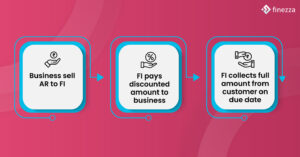The smooth functioning of a business depends on many aspects, one of them being the availability of adequate liquidity at all times. Bill discounting is a short-term financing option that helps entrepreneurs access quick cash and maintain healthy liquidity to fund growth and cover the regular expenses of their startups and businesses.
In the current digital age, where each transaction generates valuable data, collecting and analysing this data is essential for businesses of all sizes to generate detailed reports and actionable insights.
Data analytics is an emerging technology that unlocks the power of this data by expediting the process of analysis and knowledge generation. It also offers several benefits across industries to help them stay ahead of the competition and remain up-to-date with the current market trends.
In this blog post, we will discuss in detail how data analytics can help lenders in the bill discounting process.
What Is Bill Discounting?

Bill discounting is a short-term financing option; the business sells its accounts receivable (AR) to the lender or a financial institution (FI) at a discount. The FI then collects the full amount of the AR on the due date from the customer.
Next, the lenders take the bill drawn by the borrowers on their customers and pay them immediately after deducting some amount as a commission or discount. The FI presents the bill to the customer on the due date and collects the total dues.
However, if there is a delay, the borrower or the customer pays the lender interest as per the agreed terms and conditions. Factors like customer creditworthiness, business volume, and length of time when the account receivable is due determine the discount rates.
Role of Data Analytics in Enhanced Bill Discounting
Data analytics primarily involves collecting and analysing raw and unstructured data to extract meaningful and actionable insights. Leveraging data analytics gives businesses several advantages and opportunities for growth.
Now, let us explore 10 ways in which lenders can leverage data analytics and benefit from it in the bill discounting process.
1. Better Risk Assessment
Data analytics helps lenders gather and evaluate massive amounts of collected information about borrowers. As a result, they can assess a borrower’s credit risk with higher accuracy based on information like the borrower’s financial history, payment trends, credit health and industry trends.
Accurate risk assessments help lenders customise bill discounting terms aligned with the borrower’s creditworthiness, reducing the default risk and improving overall profitability.
Using tools like the Bank Statement Analyser can help make an informed decision to bring down NPAs.
2. Streamlined Operations
FIs can streamline the bill discounting process by employing analytics tools and sophisticated algorithms. Automating laborious manual processes like credit scoring, risk assessment, and decision-making can improve efficiency and reduce processing time.
Streamlining operations also reduce operation costs and helps process more credit applications resulting in higher profitability and enhanced customer satisfaction.
The Document Identifier is a valuable tool that helps extract relevant information, saves time, and reduces human-induced errors in the onboarding process.
3. Improved Regulatory Compliance
Regulatory compliance related to various aspects is mandatory for all financial entities in India. Recently, the Reserve Bank of India has laid down the rules and guidelines related to the lending process by FIs.
Data analytics can assist lenders in complying with regulations related to anti-money laundering and the Know Your Customer (KYC) process. Analysing data can help lenders address compliance-related issues proactively and reduce the risk of penalties and legal actions.
This helps lenders maintain the overall stability of operations and the credibility of their organisation.
4. Adopt a More Customer-Centric Approach
Using data analytics, lenders can segment their customers and personalise their offerings based on individual preferences and needs. Lenders can gain deeper insights into borrower behaviour to tailor terms and rates, offering captivating discounts.
This helps retain existing customers while attracting new ones. Personalised offers also strengthen customer relationships and enhance customer satisfaction.
5. Fraud Detection and Prevention
Frauds impact the overall profitability of a lender, attract penalties and damage brand reputation. Leveraging data analytics, lenders can identify and prevent fraudulent activities related to bill discounting.
A Collection Delinquency Management system uses Artificial Intelligence (AI) to help lenders safeguard their businesses from risks of fraudulent activities. By analysing patterns, historical data and outliers, they can detect suspicious activities and prevent potential fraud cases. Data analytics helps them be proactive when it comes to fraud.
6. Aids Product Development
Lenders can use data analytics to identify new opportunities for product development. They can also identify underserved segments or areas often overlooked by traditional banking channels and thereafter develop products focused on their needs and requirements.
7. Improved Decision-Making
Insights gained from analysing data help lenders make better decisions based on facts and figures.
FIs can identify patterns, anomalies, and predict market trends by studying customer behaviour, market trends, and economic indicators. Leveraging this information can aid them in optimising their lending strategies and maximising profits.
8. Real-time Monitoring and Reporting
Lenders can monitor their extensive loan portfolios and bill discounting activities in real time with data analysis tools. Access to up-to-date information and comprehensive reports gives lenders actionable insights into the performance of their bill discounting operations.
Organisations can do course correction, manage exposure and identify potential risks promptly.
9. Competitive Advantage
Financial institutions operate in a highly competitive market in current times. Leveraging data analytics for bill discounting helps them gain an advantage. Harnessing the power of data analytics, they can make informed decisions, offer customised solutions, and provide a superior customer experience giving them a competitive advantage over competitors.
10. Boost to Brand Image
Data analytics can help lenders be more transparent with their customers about bill-discounting terms and conditions, which can build a stronger relationship based on trust and confidence.
Improvement in processes, lower fraud instances and timely compliance also positively impact the business prospects and strengthen the lender’s brand image.
Key Takeaways
Overall, leveraging data analytics for enhanced bill discounting offers numerous benefits to lenders, including improved risk assessment, efficient decision-making, personalised solutions, fraud detection, streamlined operations, real-time monitoring and reporting, competitive advantage, better branding and regulatory compliance.
Finezza offers a bouquet of solutions that utilise available data to help lenders manage loans, assist in collections and streamline their credit portfolios. They also have a comprehensive analytics suite that uses Machine Learning and Big Data Analytics to help lenders in various stages and aspects of bill discounting.
Learn more about our products and contact us today for more details.




Leave a Reply